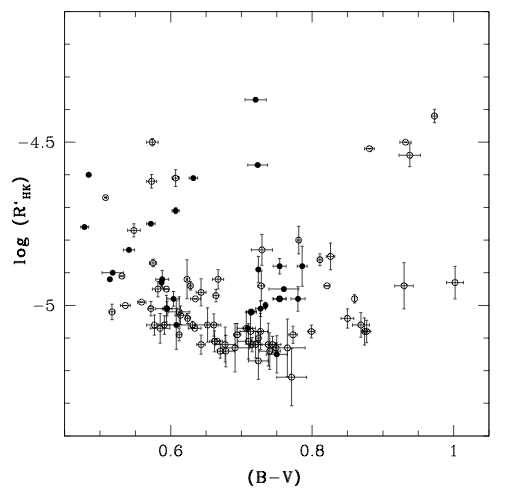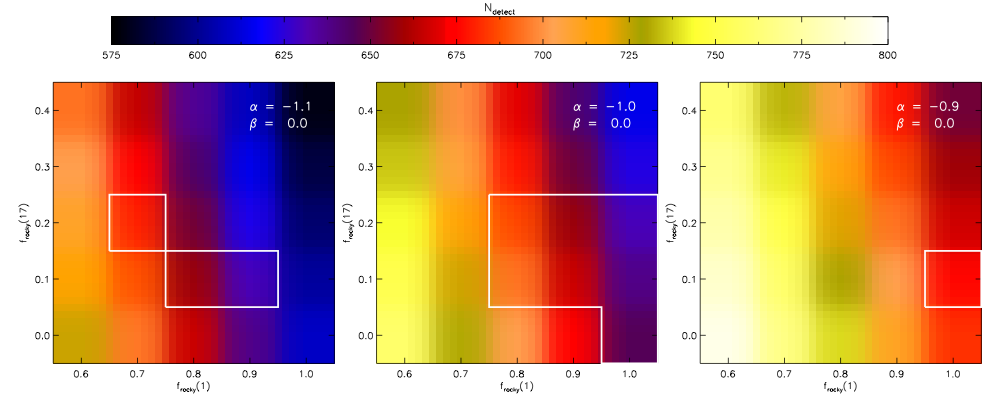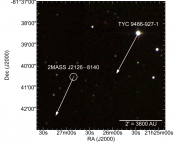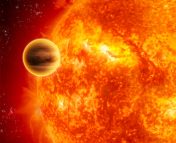- Title: A Search for Giant Planet Companions to T Tauri Stars
- Authors: Christopher J. Crockett, Naved I. Mahmud, L. Prato, Christopher M. Johns-Krull, Daniel T. Jaffe, Patrick M. Hartigan, Charles A. Beichman
- First author’s institution: U. S. Naval Observatory
The Big Picture
Many of 846 confirmed exoplanets are massive gaseous planets residing very close to their host stars. Current models of planetary formation indicate that these so-called “hot Jupiters” must have formed in the outer reaches of the protoplanetary disk and migrated (moved) inward, but astronomers don’t yet know the timescale of planetary migration. Do hot Jupiters reach their warmer environments in a few hundred thousand years or does migration require a few million years?
In this paper, the authors attempt to constrain the timescale of planetary migration by searching for hot Jupiters around very young stars. The presence of hot Jupiters around extremely young stars would indicate that planetary migration is a rather fast process, while the lack of hot Jupiters around stars younger than a certain age could place a lower limit on the timescale required for migration (assuming the occurrence rate of giant planets has been corrected for other factors like metallicity). For instance, if a gaseous planet requires 2 million years to migrate inward from the distant reaches of a protoplanetary disk, then astronomers should not expect to find hot Jupiters around stars younger than 2 million years.
The authors do not find convincing evidence that hot Jupiters orbit any of the nine young stars considered in this paper, but one of the stars is an intriguing candidate and the survey is still in progress. As the authors continue their survey, they should be able to place interesting constraints on the migration timescale for hot Jupiters and shed light on planetary formation and migration.
Working with Young Stars
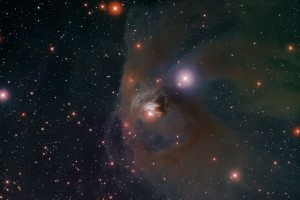
The extremely young stars considered in this study are pre-main sequence stars like T Tauri, which is hidden by dust at the center of the image. (Image Copyright: T. Rector (U. Alaska Anchorage), H. Schweiker, WIYN, NOAO, AURA, NSF)
Although the scientific motivation for investigating the presence of planets around extremely young stars is clear, the survey requirements are rather tricky. Young stars are often shrouded in dust and their surfaces are frequently mottled by star spots. These star spots are cooler than the surrounding photosphere (stellar surface) and consequently emit less radiation and appear darker than their warmer surroundings. Since star spots reduce the flux emitted from a particular region of the star and rotate along with the stellar surface, star spots can induce apparent Doppler shifts in the spectrum of the star.
These “spot-induced radial velocity variations” occur because one limb of the star is rotating toward the observer and the other limb is rotating away. When a star spot rotates into view, it blocks part of the blueshifted limb of the star, causing the overall stellar spectrum to appear slightly redshifted. As the star spot crosses the surface of the star from the blueshifted limb to the redshifted limb, the spectrum slowly appears less redshifted and more blueshifted. If a star has many star spots, then each star spot will appear to move at the rotation velocity of the star, but the star spots will have different sizes, temperatures, and positions. Each star spot will therefore introduce a slightly different Doppler shift. The combined impact of these star spots on the measured radial velocity of the star contributes to stellar “jitter.” Spot-induced jitter is one of the leading obstacles facing astronomers searching for planets using the radial velocity method because the stellar activity signal can mask the planet-induced signal.
Distinguishing Planets from Star Spots
If both planets and star spots can induce radial velocity variations, then how can astronomers hope to disentangle which signatures are due to planets and which are due only to stellar activity? The answer lies in the shape of the blackbody radiation spectrum. The flux emitted by a star spot at visible wavelengths is much less than the flux emitted by the surrounding photosphere, but the flux emitted by a star spot and the surrounding photosphere at near-infrared wavelengths is much more similar. The wavelength-dependence of the flux ratio implies that spot-induced radial velocity variations should be much stronger at visible wavelengths than at near-infrared wavelengths. Planet-induced radial velocity variations, however, should be equally strong at both optical and near-infrared wavelengths because the whole star is moving due to the gravitational influence of the planet.
The Observations
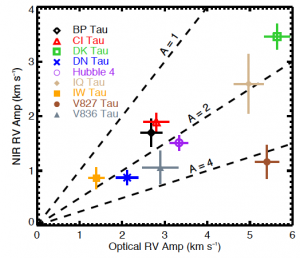
Amplitude of radial velocity variations at near-infrared wavelengths versus amplitude at optical wavelengths. The dashed lines mark fixed values of A (the ratio of near-infrared radial velocity amplitude to visible radial velocity amplitude). V827 Tau is a control star with known spots. Figure 4 from Crockett et al. 2012.
The authors are in the process of collecting radial velocity measurements for 129 very young T Tauri stars in the Taurus-Auriga star forming region and 14 slightly older stars in the Pleiades open cluster. They acquire visible spectra using the 2.7 meter Harlan J. Smith telescope at the McDonald Observatory in Texas and have completed at least 12 observations for 56 of the target stars. Thirteen of those 56 stars displayed radial velocity variations at visible wavelengths, so the authors decided to obtain follow-up near-infrared radial velocity curves for those stars to determine whether the radial velocity variations were due to planets or stellar activity.
Five of the thirteen candidate stars lack sufficient signal-to-noise ratios to make comparison between the radial velocity amplitudes at optical and infrared wavelengths, but the authors present comparisons for the remaining eight candidate stars and for a control star that is known to exhibit star spots. As displayed in the figure at right, the authors find that the radial velocity variations at infrared wavelengths are smaller than the variations at optical wavelengths for all eight of the candidate stars. The amplitude difference indicates that the observed optical radial velocity variations can be attributed to stellar activity. One of the stars (Cl Tau) displays early signs that the radial velocity variations might be due to both star spots and the presence of a planet, but further observations are required to test whether a planet is actually present.

